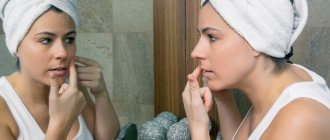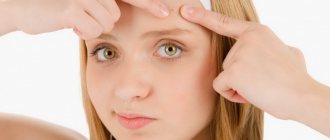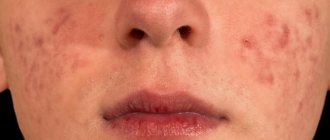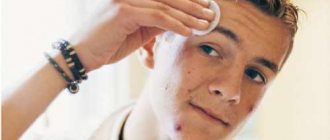- Subcutaneous pimple like a lump How to get rid of it on the face, cheek
- Difference between subcutaneous lumps and cyst
- Causes and symptoms of acne in the form of bumps on the face and body
- How to get rid of subcutaneous internal acne Best home remedies
In the next article, we will tell you about the causes and methods of getting rid of such specific acne on the face as subcutaneous acne, protruding in the form of bumps, formations. You will also learn about some home remedies that can help significantly reduce the size of subcutaneous bumps and get rid of them forever.
Subcutaneous pimple like a lump How to get rid of it on the face, cheek
Large subcutaneous pimples on the skin of the face are most often characterized in medical circles as Atheromas, which can appear on any part of your body where hair grows. These bumps under your skin appear when, for some reason, the sebaceous glands are blocked, containing excess subcutaneous sebum.
The most common places on your body for atheromas are on your head, neck, forehead or cheeks, chest. Unlike other pimples, which are filled with fluid, atheromas are filled with sebum, which is like 100% oil excreted by your sebaceous glands.
Typically, the only symptom of subcutaneous lumps or atheromas is a bump or small tumor under your skin. Since their presence does not cause much harm to your skin, doctors usually do not recommend surgical removal of atheromas.
A warm compress is the most common way to quickly get rid of atheroma at home.
What are Atheroma or internal subcutaneous bumps?
Each hair follicle contains a tiny sebaceous gland that produces an oily substance called sebum. If these glands or follicles are blocked, sebaceous reserves grow significantly in the gland causing an atheroma, a subcutaneous lump, to appear and grow.
Dr. Stephanie S. Gardner says these cysts are usually small, painless lumps that appear under the skin, but they often come in larger lump-like forms.
Risks Associated with Huge Pimples
Huge bumpy pimples are already a fairly severe form of acne, but if left untreated they can actually worsen, developing into even more severe infectious forms. This process occurs when cysts that are close to each other join together and affect the pores and channels under the skin, destroy cells and cause even more inflammation. Such reactions subsequently develop into chronic acne, after which you can experience deep abscesses, scars and serious damage to the skin.
Blackhead and white pimples
Oil, dead skin cells and bacteria block the pores and cause large bumps. If the blocked pores subsequently become open, then they can look like a black hole in the skin on the face or body. If the blocked pores continue further, then the top part of the bump will appear whiter.
Cystic acne: treatment and causes.
Papules and pustules
Sometimes the pores become so irritated that their walls burst This causes large pimples called papules and pustules Papules are quite painful, especially when you touch them A cluster of papules that are close to each other can make your skin feel like sandpaper Pustules are similar to papules , but differ only in the yellowish, liquid pus that fills the bladder from the inside.
Difference between subcutaneous lumps and cyst
Poll: When did your acne appear? (Number of votes: 4295)
I've been suffering all my life
It's been a couple of years now
About a few months
Recently
To vote, click on the desired answer. results
According to doctors, atheromas in the form of internal lumps are less common than cysts. The difference between them is that cysts form when the protein keratin blocks oil tonsils or hair follicles.
Atheromas appear when the fat that protects your skin blocks the gland. However, the visible symptoms of both of these types of cysts are very similar, and therefore only your attending physician can give an accurate diagnosis and prescribe the correct treatment.
Internal subcutaneous pimple
Preventive manipulations
To ensure that subcutaneous pimple bumps no longer bother you, the following preventive measures should be observed:
food must necessarily consist of nuts, buckwheat, vegetables, herbs and fresh fruits;- Bakery products, sugar, milk, mayonnaise, margarine and fatty foods should be excluded from the diet;
- minimize/eliminate the consumption of alcoholic beverages;
- quit smoking;
- drink at least 1.5-2 liters of purified water without gas during the day;
- lead an active lifestyle, play sports;
- spend time in the fresh air as often as possible;
- learn how to choose the right cosmetic products for skin care in accordance with its type;
- It is better to use peeling instead of scrub, since its abrasive particles are smaller;
- give preference to foundations that do not clog pores;
- compact powder should be replaced with loose powder, which has a lighter structure and allows oxygen to pass through.
Originally posted 2018-01-31 08:33:38.
How to get rid of subcutaneous internal acne Best home remedies
These natural home remedies for bumps on face and body help reduce the swelling and help the cyst disappear naturally and painlessly. This natural treatment will also help prevent the area of the swollen bump from getting various types of infections.
Please remember that, in order to reduce the risk of infection, you should always cleanse the area around your pimples completely before using any of these natural remedies.
Warm compress
One of the best and easiest ways to get rid of subcutaneous bumps is to use a warm compress of plain water. This can help remove the cyst without causing inflammation or irritating the cyst. This is also one of the recommended home treatments for internal pimples, noted by many doctors. , specializing in the problem of acne.
How to use:
To get rid of subcutaneous bumps without surgery using a warm compress, follow these steps:
- Gently cleanse the damaged area of skin around the cyst with tar soap.
- Apply a damp, warm washcloth to the subcutaneous bumps and hold for 20 - 30 minutes.
- Once the washcloth has cooled, warm it up again by placing it in hot water.
- Repeat this procedure 3 to 4 times a day to help increase blood circulation in the sebaceous gland area and speed up the healing process of internal acne.
Continue to do this until the swelling is significantly reduced and begins to disappear.
When pus begins to come out of the pimple, gently wash the bump and wipe away the pus to prevent any infection from spreading.
Doctors at New York City's WebMD Clinic also advise that you be careful not to cause too much burning of the skin, so that the warm compress is not too hot. It may take weeks of treatment to achieve visible results in reducing bumps on the body and face.
Tea tree oil
Tea tree oil contains natural anti-inflammatory and antibacterial properties that can help treat internal and subcutaneous bumpy pimples. You can also mix some tea tree oil with coconut oil to soften the skin and help the body eliminate cysts.
How to use:
For this natural home remedy, you will need some tea tree oil, coconut oil and a band-aid.
- Mix 1 tablespoon of coconut oil with 2 - 3 drops of tea tree oil.
- Apply some cyst medicine and secure it with adhesive tape.
- Repeat the procedure 2 - 3 times a day to quickly get rid of bumps and subcutaneous pimples at home.
- If you have used the compress method on your face or body, you can also, for a better treatment effect, apply tea tree oil and coconut oil. This will prevent the infection from spreading, and will help quickly reduce the redness and swelling around the infected bumps.
Witch hazel
Witch hazel - acne remedy
Witch hazel is a natural healing astringent that helps increase the blood circulation process and speeds up the acne healing process. You can also use the anti-inflammatory properties of witch hazel to help treat atheroma.
Witch hazel is used to relieve pain, itching, and swelling of the skin, as well as other irritations. The astringent properties of witch hazel come from the unique pigment components of witch hazel, which also help fight bacteria that enter the skin.
How to use:
- Soak a cotton swab in the witch hazel solution.
- Apply the swab to the inflamed lumps for about 10 minutes to allow the witch hazel to be absorbed into the lump.
- Repeat the process 3 – 4 times a day to help the pimples and bumps finally clear up.
Witch hazel is especially useful in treating atheromas, which cause itching and minor skin irritations. Witch hazel is also used to get rid of all types of acne, including cystic acne.
Aloe vera
Aloe vera remedy for acne
Aloe vera is a natural healer for many skin conditions. You can use aloe vera daily to shrink cysts and get rid of internal pimples and bumps under your skin.
Why is aloe vera so effective for your skin?
The Indian Journal of Dermatology has reported that aloe vera contains many therapeutic properties for skin health. It contains vitamins and beneficial enzymes that help keep your skin healthy. It is antiseptic which in nature can help you fight bacterial skin infections and reduce inflammation. Aloe vera also improves skin collagen, thus reducing scarring, and helps wounds and acne scars heal faster.
How to use:
- To help remove atheroma and internal pimple bumps, use aloe vera daily
- Apply aloe vera gel to the atheroma and gently massage into the affected area of the skin.
- Let the aloe dry and leave it on your skin for 15 to 20 minutes.
- Repeat the procedure for a faster healing process 3 - 4 times a day.
Apple vinegar
Apple cider vinegar for acne
You can use apple cider vinegar as a useful home remedy to treat subcutaneous pimples and bumps at home. Apple cider vinegar helps keep skin healthy by removing bacteria from under the skin and unclogging facial pores. It is also a wonderful natural method for treating itchy skin, including getting rid of discomfort that some atheromas cause.
How to use:
- Mix equal parts apple cider vinegar and water (using undiluted vinegar may cause skin burns).
- Soak a cotton swab in diluted raw apple cider vinegar and squeeze out excess liquid.
- Apply the tampon directly to the site of the lump formation and hold for 15 - 20 minutes,
- To better soften the skin and speed up the healing process, repeat the process daily until the pus can drain out of the cyst easily.
Castor oil
To remove atheroma, the healing properties of castor oil are used in combination with a warm compress.
Castor oil for acne
Castor oil is used to get rid of bumps and subcutaneous pimples on the skin of the face and body, but castor oil will also help to significantly reduce itching, inflammation and remove bacteria from under the skin that can cause other skin problems.
How to use:
- Pour some castor oil onto a clean cotton pad and press it onto the bump.
- Apply a warm compress to the bump for 5 - 10 minutes. To do this, you can use a heating pad, a warm washcloth or a heat pad.
- Repeat the procedure 2 times a day
Atheroma and subcutaneous lumps - when to see a doctor
In most cases, atheromas are simply harmless tumors. However, in some cases, a tumor under your skin should be examined by a doctor. Many people also resort to surgical removal of atheromas and subcutaneous lumps.
Doctors recommend consulting a doctor for cyst treatment in the following cases:
- The tumor begins to grow rapidly.
- You notice symptoms of infection such as redness, swelling, and pus around the cyst area.
- Pimples or bumps under your skin are in an area that is constantly irritated.
- Atheroma greatly spoils your appearance, and you want to remove it forever.
Our readers recommend using tea tree oil for acne!
Consequences
Opening subcutaneous pimples is strictly prohibited.
- After squeezing out, the pus spreads to healthy tissue. This inevitably leads to the formation of new inflammations. And instead of one pimple, several appear.
- The pus remaining after opening will penetrate even deeper under the skin. Which causes the formation of even more painful inflammation. Healing takes many weeks.
- And in some cases, pus has to be removed surgically. An atrophic scar or a blue pigment spot inevitably remains at the site of the wound.
Trying to puncture a pimple with a needle and then squeezing out the pus also leads to nothing.
The purulent contents are very deep.
But not everyone manages to restrain themselves and leave the pimple alone. Often many people still try to extract the pus out.
If after squeezing out a pimple a lump forms, this indicates that its contents did not come out completely.
- The lump must be treated with an antiseptic (boric alcohol, salicylic acid, Chlorhexidine).
- And then lubricate the abscess with antibacterial ointment (“Klindovit”, “Dalacin”).
Photo: ripe pimple
After which you should still wait for the abscess to mature.
Useful tips
In addition to an integrated approach to acne treatment and compliance with preventive measures, cosmetologists recommend following simple recommendations.
These lifestyle tips will help you avoid new breakouts:
- The skin needs cleansing, so you should take a shower every day. You should take a bath at least once a week;
- it is important to have separate towels for the face, hands, feet and bath;
- It is better to replace water for morning washing with a decoction of calendula, chamomile or sage. Rubbing the skin with ice cubes made from herbal infusions is no less effective;
- You should not wear clothes with rough seams or straps that rub the skin;
- You should choose a washcloth that is soft and does not injure the skin.
The main cause of subcutaneous acne is hidden inside the body..
Any failures and malfunctions in the functioning of internal organs lead to disruption of the appearance of the skin.
Therefore, you should be examined by a gastroenterologist or endocrinologist. Especially if pimples appear frequently, and external treatment relieves them only for a short period of time.










